The must-try foods from every region of Italy

Italy is synonymous with good food, and yet Italian cuisine is often thought of abroad as little more than pizza and pasta. If you’ve spent any amount of time in the country, though, you’ll know every region has its own distinct cuisine.
So in case you need an excuse to eat yet more delicious Italian food, here’s our guide to the best local dishes in every single one of the country’s 20 regions. What are you waiting for?
Aosta Valley
A long way from the famously light Mediterranean diet, kitchens in the mountainous Valle d'Aosta region are full of red meat, cheese, butter and carbs. A favourite dish is Carbonada; beef is sliced thinly and browned in butter before being slowly stewed for hours in red wine flavoured with thyme, cinnamon and cloves.
It’s served over a pile of polenta or thick ribbons of pappardelle, with a glass of red wine. Just what you need after a day on the ski slopes or mountain trails.
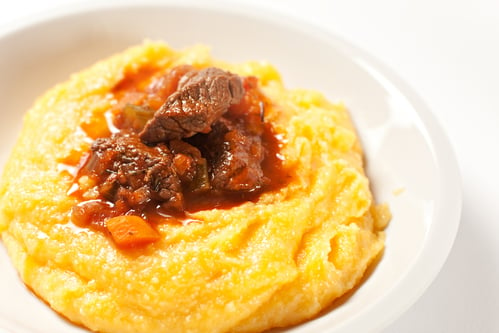
Comforting beef stew and polenta is popular in Valle d'Aosta. Photo: svariophoto/Depositphoto
Abruzzo
The whole region of Abruzzo is crazy for arrosticini. These small grilled lamb or mutton skewers are cooked on a special gutter-shaped brazier, called a fornacella or canala.
What makes them arrosticini and not just any old barbecued kebab skewer? Firstly the meat is cut into 1cm cubes, importantly including plenty of fat, and packed tightly onto the wooden skewer before being cooked surprisingly slowly over charcoal. The fat and charcoal grilling produces some serious flavour. Real arrosticini fans will want to visit the area the foot of the Voltigno mountain in the province of Pescara, where the skewers are legendary.
Basilicata
This wild and beautiful region is home to one of the oldest cities in the world, Matera, and has long been known as a poor and very rural part of Italy. This is reflected in its simple but delicious cuisine.
Matera itself is famous for its crusty bread, while one of the most typical dishes found across the region is a simple soup called acquasale. Every family has its own recipe, but it usually involves frying onion with extra-virgin olive oil, salt, tomato, peppers, oregano or pepperoncino and adding water to make a thin soup, which is then poured over toasted rye bread.
Calabria
Very spicy foods are scarce in Italy, but for the exception head down to Calabria where the red chilli pepper (peperoncino) sneaks its way into almost everything.
Some of the most common ways to use peperoncino are either with pasta in a penne all’arrabbiata (literally ‘angry’ penne pasta), which can be found across Italy, or in the Calabrese ‘nduja; a kind of spicy, spreadable sausage made with pork and plenty of chilli. Peperoncino is often dried and ground into a powder, but that doesn’t make the spice any milder. It’s then sprinkled on everything from pizza to veggies.
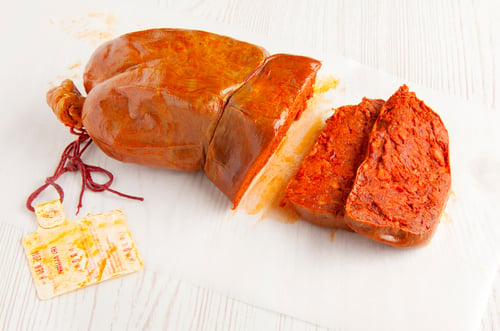
Italian spicy sausage 'nduja. Photo: IriGri/Depositphoto.
Campania
Everyone wants to try an authentic pizza when they come to Italy and, along with Rome, Naples is the place to do it. Neapolitan pizza bases are thicker and squidgier than their Roman counterparts – meaning you can pile more toppings on. A favourite is buffalo mozzarella, which is produced in the Campania region.
One of the city’s most famous pizzerias, Sorbillo, has a perpetual line out of the door for a table at its seafront location. However there are several neighbouring pizzerias where the cooking, view and atmosphere is every bit as good.
Emilia-Romagna
Those who come to Italy looking for spaghetti bolognese may be disappointed to find that technically, it doesn't exist. The closest thing Italians have to ‘spag bol’ is the Ragù alla Bolognese loved in this region; a sauce of minced beef and pork with carrots, onion and celery in tomato sugo. And it's not usually served with spaghetti, but tagliatelle or pappardelle.
It is however very acceptable to smother it in grated Parmigiano Reggiano cheese - the real stuff is made in the Emilia-Romagna region and in a small area of Lombardy.
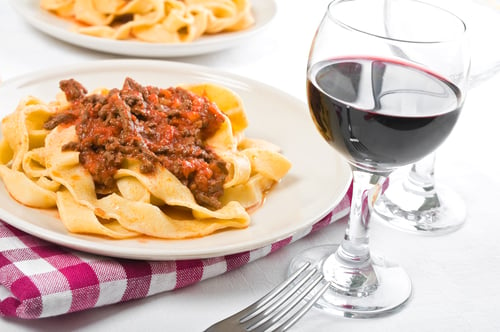
Typical Bolognese ragu served with pappardelle. Photo: milla74/Depositphoto
Friuli-Venezia-Giulia
Although Parma ham is much more famous abroad, Italians know that the area of San Daniele, in the north-eastern region of Fruili Venezia Giulia, produces some of the most delicious, melt-in-the-mouth prosciutto in all of Italy. The area’s microclimate and the quality of the meat combine during the curing process to produce a soft, sweet ham with a distinctive flavour. It’s a must-try if you’re in the region and, if you can’t find it on a restaurant menu, a local deli will have plenty.
Lazio
Traditional Roman Carbonara is made with just four basic ingredients: guanciale (cured pork jowl), eggs, pecorino romano cheese and black pepper. That means no cream, ever. It’s totally unnecessary since the raw egg and cheese mixture is what gives the dish its ‘creamy’ texture.
The origins of Carbonara are mysterious, but since the name is thought to be derived from the Italian word for charcoal, it’s said to have been a filling meal first made for coal miners.
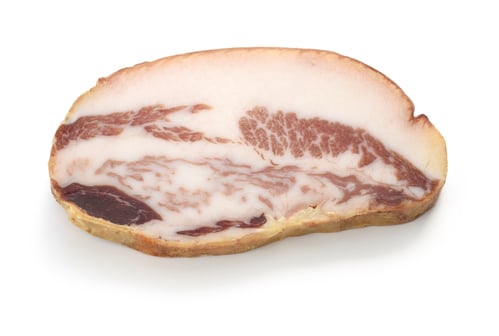
Salt-cured guanciale is an integral ingredient in spaghetti carbonara. Photo: asimojet/Depositphoto
And we couldn’t leave out the now-trendy cacio e pepe, a simple spaghetti dish made with ground black pepper and pecorino cheese. Some trattorias, like Da Danilo in Rome, make a show of finishing off the pasta next to your table by swirling it inside a hollowed-out round of pecorino.
Liguria
Traditional Genoan pesto is a tribute to two of the most wonderful fresh ingredients found in the Liguria region: small leaves of fresh basil, and aromatic extra virgin olive oil. It’s ground together with garlic, parmesan, pecorino, salt, pine nuts and quite a lot of patience. This national treasure is perfect with Ligurian pastas, including trofie and trenette, and you’ll often find this is served with potatoes and green beans.
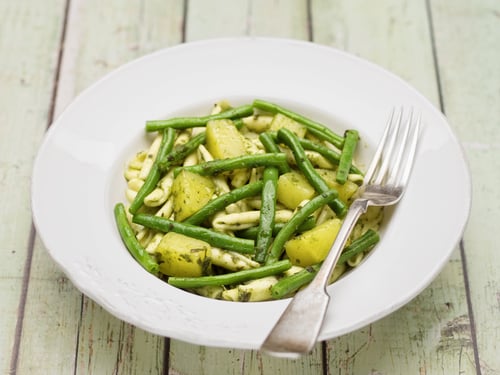
A rustic-style pasta genovese. Photo: zkruger/depositphoto
Lombardy
This northern region bordering Switzerland is home to some of Italy’s most famous dishes, such as bresaola and cottolette alla Milanese. Risottos are very popular here, as is Cassouela, a casserole made with pork meat, cabbage, and various other ingredients depending on the area. Despite the similar-sounding name it’s pretty different to a French cassoulet. It’s usually served with creamy polenta and a strong red wine.
Marche
There are lots of reasons for foodies to explore Marche, but hunting down a bowl of brodetto should be high on the list. Ancona's classic dish, brodetto all'anconetana, uses the fantastic variety of local seafood and reflects the city's seafaring heritage. It's a rich, slightly spicy, tomato-based soup, resembling bouillabaisse, made from a mix of whatever the local catch contains that day, which could be anything from cod to cuttlefish. The dish was originally made on board fishing boats for lunch but is now enjoyed in the city’s best restaurants, too.
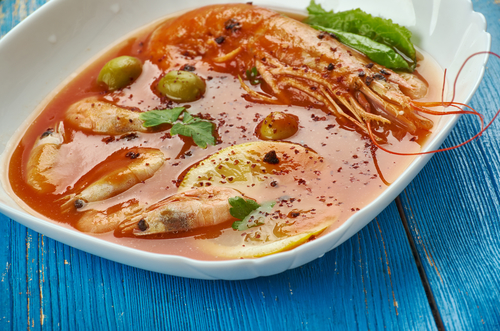
A typical brodetto all'anconetana. Photo: fanfon/Depositphoto.
Molise
If you’re visiting this lesser-known region, locals will tell you to try the baccala arracanato, or cod gratin. In this unusual dish, cod is baked by putting it inside the fireplace, or inside a fire pit, covering the pan with smouldering embers and leaving it to cook slowly. The fish is coated with breadcrumbs, pine nuts and walnuts, raisins, olives and cherry tomatoes. Using an oven, apparently, will not produce the right kind of flavour, so it’s worth finding a kitchen that cooks it the traditional way.
Puglia
Surrounded on three sides by water, it’s no surprise that this region loves raw seafood, especially polipetti (baby octopus) eaten whole with just a squeeze of lemon.
Then there’s the egg-free durum wheat pasta, usually found as small cavatelli or orecchiette (little ears). For the most classic Pugliese primo (first course), they’re tossed with cime di rape (broccoli rabe), tomato, a little olive oil and seasoning, sometimes including chopped anchovies.
Piedmont
Piedmont is a magical region for food and drink lovers. The fertile land around Turin is home to some of Italy’s best wines (Barolo and Barbaresco), which are used here to make rich stews, sauces and even an indulgent red wine risotto.
Its misty valleys are known for producing excellent hazelnuts, used in the typical gianduja hazelnut cream chocolate. You can try melt-in-the-mouth giandujotti chocolates in cafes and chocolate shops anywhere in the region - except for in the heat of summer, when they’d melt on the shelf. Turin is also famously the place where Nutella spread was invented.
.jpg)
Risotto is a favourite dish in Turin and all over Piedmont. Photo: Clare Speak/The Local
Sardinia
As well as its famous seafood, the island of Sardinia eats lots of seadas. These pastries are the perfect combination of sweet and savoury, and can be eaten as either anantipasto or a dessert. They’re big ravioli-shaped parcels of rustic semolina pastry, filled with lemon-infused pecorino cheese, deep-fried and drizzled with honey. You can find seadas all over the island - just make sure they’re freshly fried so you can enjoy them warm while the cheese is soft and melted.
Sicily
The famous Sicilian cannoli can be found across the world nowadays, but nothing beats the real thing. These hollow tubes of crisp pastry are filled with a sweetened ricotta cheese and decorated with candied fruit, chocolate or chopped pistachio.
Cannoli are thought to have originated in Palermo under Arab rule. They were traditionally eaten only during Carnival, but now can be found all over the island at any time of year.

Sicilian cannoli filled with sweet ricotta cream. Photo: uroszuric/Depositphoto
Trentino-South Tyrol
Italy's northernmost region has a split personality. It was part of the Austro-Hungarian Empire until its collapse after World War I. As with the language, cooking here comes with an Austrian accent. Unsurprisingly strudel is very popular here, with apple, pear, blackberry and all kinds of other fillings. You can find it in almost any restaurant, but El Pael serves vast and high quality portions along with local history lessons.
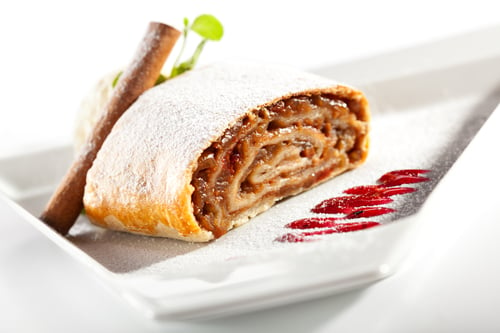
Apple strudel is a favourite in northern Italy. Photo: rhyzkov86/Depositphoto
Tuscany
While Florence and the surrounding region is now becoming famous for the bistecca alla Fiorentina - a thick slab of steak simply grilled and seasoned to perfection - people didn’t eat beef here until relatively recently. Eating your expensive cattle would’ve once been seen as madness, especially when the nearby forests were full of game.
Instead cinghiale, or wild boar, was (and still is) more popular locally. Pappardelle al sugo di cinghiale might be the most characteristic Tuscan dish; a rich, slow-cooked tomato sauce with wild boar meat served over pappardelle pasta ribbons, best with a glass of Chianti Classico.
Umbria
Much like Tuscany, the forests hold the biggest culinary treasures in this hilly central region. And truffles are the star of the show. The tartufo nero (black truffle), which grows just below ground level all over the forested region, finds its way into almost everything.
Still more prized is the tartufo bianco (white truffle) found around Gubbio in late autumn. Restaurants like Taverna del Lupo toss fresh, handmade pasta with a little butter and grated Parmigiano, and then sprinkle the grated truffle liberally on top.
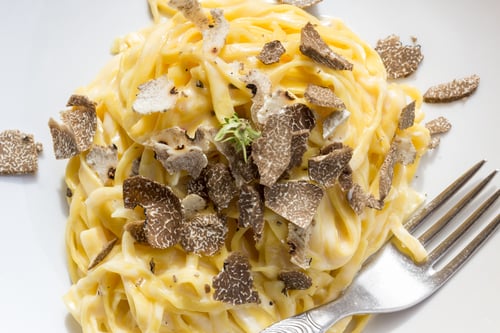
A simple tagliatelle dish with truffles and cheese. Photo: Eva50/Depositphoto
Veneto
Seafood is king here and popular dishes include deep-fried crispy crabs and all kinds of fish soups and stews. The most characteristic recipe though might be sarde in saor. This sweet-sour dish is made with fried sardine fillets marinated in vinegar, onions, raisins and pine nuts.
The recipe was originally a method of preserving fish used by Venetian sailors and fishermen, and though they no longer need to preserve fish in this way, the flavour is so popular that it lives on as a modern-day antipasto.
READ ALSO: The words and phrases you need to know to decipher Italy's restaurant menus
This article was originally published in 2018.
Comments
See Also
So in case you need an excuse to eat yet more delicious Italian food, here’s our guide to the best local dishes in every single one of the country’s 20 regions. What are you waiting for?
Aosta Valley
A long way from the famously light Mediterranean diet, kitchens in the mountainous Valle d'Aosta region are full of red meat, cheese, butter and carbs. A favourite dish is Carbonada; beef is sliced thinly and browned in butter before being slowly stewed for hours in red wine flavoured with thyme, cinnamon and cloves.
It’s served over a pile of polenta or thick ribbons of pappardelle, with a glass of red wine. Just what you need after a day on the ski slopes or mountain trails.

Comforting beef stew and polenta is popular in Valle d'Aosta. Photo: svariophoto/Depositphoto
Abruzzo
The whole region of Abruzzo is crazy for arrosticini. These small grilled lamb or mutton skewers are cooked on a special gutter-shaped brazier, called a fornacella or canala.
What makes them arrosticini and not just any old barbecued kebab skewer? Firstly the meat is cut into 1cm cubes, importantly including plenty of fat, and packed tightly onto the wooden skewer before being cooked surprisingly slowly over charcoal. The fat and charcoal grilling produces some serious flavour. Real arrosticini fans will want to visit the area the foot of the Voltigno mountain in the province of Pescara, where the skewers are legendary.
Basilicata
This wild and beautiful region is home to one of the oldest cities in the world, Matera, and has long been known as a poor and very rural part of Italy. This is reflected in its simple but delicious cuisine.
Matera itself is famous for its crusty bread, while one of the most typical dishes found across the region is a simple soup called acquasale. Every family has its own recipe, but it usually involves frying onion with extra-virgin olive oil, salt, tomato, peppers, oregano or pepperoncino and adding water to make a thin soup, which is then poured over toasted rye bread.
Calabria
Very spicy foods are scarce in Italy, but for the exception head down to Calabria where the red chilli pepper (peperoncino) sneaks its way into almost everything.
Some of the most common ways to use peperoncino are either with pasta in a penne all’arrabbiata (literally ‘angry’ penne pasta), which can be found across Italy, or in the Calabrese ‘nduja; a kind of spicy, spreadable sausage made with pork and plenty of chilli. Peperoncino is often dried and ground into a powder, but that doesn’t make the spice any milder. It’s then sprinkled on everything from pizza to veggies.

Italian spicy sausage 'nduja. Photo: IriGri/Depositphoto.
Campania
Everyone wants to try an authentic pizza when they come to Italy and, along with Rome, Naples is the place to do it. Neapolitan pizza bases are thicker and squidgier than their Roman counterparts – meaning you can pile more toppings on. A favourite is buffalo mozzarella, which is produced in the Campania region.
One of the city’s most famous pizzerias, Sorbillo, has a perpetual line out of the door for a table at its seafront location. However there are several neighbouring pizzerias where the cooking, view and atmosphere is every bit as good.
Emilia-Romagna
Those who come to Italy looking for spaghetti bolognese may be disappointed to find that technically, it doesn't exist. The closest thing Italians have to ‘spag bol’ is the Ragù alla Bolognese loved in this region; a sauce of minced beef and pork with carrots, onion and celery in tomato sugo. And it's not usually served with spaghetti, but tagliatelle or pappardelle.
It is however very acceptable to smother it in grated Parmigiano Reggiano cheese - the real stuff is made in the Emilia-Romagna region and in a small area of Lombardy.

Typical Bolognese ragu served with pappardelle. Photo: milla74/Depositphoto
Friuli-Venezia-Giulia
Although Parma ham is much more famous abroad, Italians know that the area of San Daniele, in the north-eastern region of Fruili Venezia Giulia, produces some of the most delicious, melt-in-the-mouth prosciutto in all of Italy. The area’s microclimate and the quality of the meat combine during the curing process to produce a soft, sweet ham with a distinctive flavour. It’s a must-try if you’re in the region and, if you can’t find it on a restaurant menu, a local deli will have plenty.
Lazio
Traditional Roman Carbonara is made with just four basic ingredients: guanciale (cured pork jowl), eggs, pecorino romano cheese and black pepper. That means no cream, ever. It’s totally unnecessary since the raw egg and cheese mixture is what gives the dish its ‘creamy’ texture.
The origins of Carbonara are mysterious, but since the name is thought to be derived from the Italian word for charcoal, it’s said to have been a filling meal first made for coal miners.

Salt-cured guanciale is an integral ingredient in spaghetti carbonara. Photo: asimojet/Depositphoto
And we couldn’t leave out the now-trendy cacio e pepe, a simple spaghetti dish made with ground black pepper and pecorino cheese. Some trattorias, like Da Danilo in Rome, make a show of finishing off the pasta next to your table by swirling it inside a hollowed-out round of pecorino.
Liguria
Traditional Genoan pesto is a tribute to two of the most wonderful fresh ingredients found in the Liguria region: small leaves of fresh basil, and aromatic extra virgin olive oil. It’s ground together with garlic, parmesan, pecorino, salt, pine nuts and quite a lot of patience. This national treasure is perfect with Ligurian pastas, including trofie and trenette, and you’ll often find this is served with potatoes and green beans.

A rustic-style pasta genovese. Photo: zkruger/depositphoto
Lombardy
This northern region bordering Switzerland is home to some of Italy’s most famous dishes, such as bresaola and cottolette alla Milanese. Risottos are very popular here, as is Cassouela, a casserole made with pork meat, cabbage, and various other ingredients depending on the area. Despite the similar-sounding name it’s pretty different to a French cassoulet. It’s usually served with creamy polenta and a strong red wine.
Marche
There are lots of reasons for foodies to explore Marche, but hunting down a bowl of brodetto should be high on the list. Ancona's classic dish, brodetto all'anconetana, uses the fantastic variety of local seafood and reflects the city's seafaring heritage. It's a rich, slightly spicy, tomato-based soup, resembling bouillabaisse, made from a mix of whatever the local catch contains that day, which could be anything from cod to cuttlefish. The dish was originally made on board fishing boats for lunch but is now enjoyed in the city’s best restaurants, too.

A typical brodetto all'anconetana. Photo: fanfon/Depositphoto.
Molise
If you’re visiting this lesser-known region, locals will tell you to try the baccala arracanato, or cod gratin. In this unusual dish, cod is baked by putting it inside the fireplace, or inside a fire pit, covering the pan with smouldering embers and leaving it to cook slowly. The fish is coated with breadcrumbs, pine nuts and walnuts, raisins, olives and cherry tomatoes. Using an oven, apparently, will not produce the right kind of flavour, so it’s worth finding a kitchen that cooks it the traditional way.
Puglia
Surrounded on three sides by water, it’s no surprise that this region loves raw seafood, especially polipetti (baby octopus) eaten whole with just a squeeze of lemon.
Then there’s the egg-free durum wheat pasta, usually found as small cavatelli or orecchiette (little ears). For the most classic Pugliese primo (first course), they’re tossed with cime di rape (broccoli rabe), tomato, a little olive oil and seasoning, sometimes including chopped anchovies.
Piedmont
Piedmont is a magical region for food and drink lovers. The fertile land around Turin is home to some of Italy’s best wines (Barolo and Barbaresco), which are used here to make rich stews, sauces and even an indulgent red wine risotto.
Its misty valleys are known for producing excellent hazelnuts, used in the typical gianduja hazelnut cream chocolate. You can try melt-in-the-mouth giandujotti chocolates in cafes and chocolate shops anywhere in the region - except for in the heat of summer, when they’d melt on the shelf. Turin is also famously the place where Nutella spread was invented.
.jpg)
Risotto is a favourite dish in Turin and all over Piedmont. Photo: Clare Speak/The Local
Sardinia
As well as its famous seafood, the island of Sardinia eats lots of seadas. These pastries are the perfect combination of sweet and savoury, and can be eaten as either anantipasto or a dessert. They’re big ravioli-shaped parcels of rustic semolina pastry, filled with lemon-infused pecorino cheese, deep-fried and drizzled with honey. You can find seadas all over the island - just make sure they’re freshly fried so you can enjoy them warm while the cheese is soft and melted.
Sicily
The famous Sicilian cannoli can be found across the world nowadays, but nothing beats the real thing. These hollow tubes of crisp pastry are filled with a sweetened ricotta cheese and decorated with candied fruit, chocolate or chopped pistachio.
Cannoli are thought to have originated in Palermo under Arab rule. They were traditionally eaten only during Carnival, but now can be found all over the island at any time of year.

Sicilian cannoli filled with sweet ricotta cream. Photo: uroszuric/Depositphoto
Trentino-South Tyrol
Italy's northernmost region has a split personality. It was part of the Austro-Hungarian Empire until its collapse after World War I. As with the language, cooking here comes with an Austrian accent. Unsurprisingly strudel is very popular here, with apple, pear, blackberry and all kinds of other fillings. You can find it in almost any restaurant, but El Pael serves vast and high quality portions along with local history lessons.

Apple strudel is a favourite in northern Italy. Photo: rhyzkov86/Depositphoto
Tuscany
While Florence and the surrounding region is now becoming famous for the bistecca alla Fiorentina - a thick slab of steak simply grilled and seasoned to perfection - people didn’t eat beef here until relatively recently. Eating your expensive cattle would’ve once been seen as madness, especially when the nearby forests were full of game.
Instead cinghiale, or wild boar, was (and still is) more popular locally. Pappardelle al sugo di cinghiale might be the most characteristic Tuscan dish; a rich, slow-cooked tomato sauce with wild boar meat served over pappardelle pasta ribbons, best with a glass of Chianti Classico.
Umbria
Much like Tuscany, the forests hold the biggest culinary treasures in this hilly central region. And truffles are the star of the show. The tartufo nero (black truffle), which grows just below ground level all over the forested region, finds its way into almost everything.
Still more prized is the tartufo bianco (white truffle) found around Gubbio in late autumn. Restaurants like Taverna del Lupo toss fresh, handmade pasta with a little butter and grated Parmigiano, and then sprinkle the grated truffle liberally on top.

A simple tagliatelle dish with truffles and cheese. Photo: Eva50/Depositphoto
Veneto
Seafood is king here and popular dishes include deep-fried crispy crabs and all kinds of fish soups and stews. The most characteristic recipe though might be sarde in saor. This sweet-sour dish is made with fried sardine fillets marinated in vinegar, onions, raisins and pine nuts.
The recipe was originally a method of preserving fish used by Venetian sailors and fishermen, and though they no longer need to preserve fish in this way, the flavour is so popular that it lives on as a modern-day antipasto.
READ ALSO: The words and phrases you need to know to decipher Italy's restaurant menus
This article was originally published in 2018.
Join the conversation in our comments section below. Share your own views and experience and if you have a question or suggestion for our journalists then email us at [email protected].
Please keep comments civil, constructive and on topic – and make sure to read our terms of use before getting involved.
Please log in here to leave a comment.